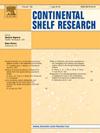Sulfonamides as emerging contaminants in China's marginal seas: Distribution, Usage, and Residues
IF 2.2
3区 地球科学
Q2 OCEANOGRAPHY
引用次数: 0
Abstract
Sulfonamides (SAs), widely used in human and veterinary medicine, enter the environment through metabolism and accumulate in marine ecosystems, affecting both marine ecosystems and human health. However, there is a lack of systematic research in China regarding the relationship between the usage inputs of SAs and their marine fate. This study presented a comprehensive analysis of data regarding SAs in the marginal seas of China and the usage of SAs from 2009 to 2020 what we can collect, focusing on the distribution and fate of SAs in China's marginal seas. Results supported by restrictive data indicated 22 types of SAs in seawater and 17 in sediments, with sulfamethoxazole and trimethoprim being the two primary SAs. Total SAs concentration in seawater ranged from 0.12 ng/L to 309.71 ng/L, while in sediments it ranged from 0.07 ng/g to 360.4 ng/g, with the Bohai Sea being the most severely polluted marine area by SAs in China. SAs residues varied significantly by year, ranging from 3 tons to 242 tons in the Bohai Sea and from 7 tons to 316 tons in the Yellow Sea. It is noteworthy that the residues of SAs in both the Bohai Sea and Yellow Sea have markedly decreased in recent years, reflecting reduced pollution levels likely attributed to factors such as reduced usage of SAs due to national regulatory measures. This study holds significant scientific value for systematically understanding the status of SAs in China's marginal seas, as well as for formulating strategies for the use, emission, and pollution management of emerging contaminants including SAs.

磺胺类污染物在中国边缘海域的分布、使用和残留
磺胺类物质广泛应用于人类和兽药中,通过代谢进入环境,在海洋生态系统中积累,既影响海洋生态系统,也影响人类健康。然而,国内缺乏系统的研究,主要集中在硫酸盐的使用投入与海洋命运之间的关系。本文综合分析了2009 - 2020年中国边缘海SAs的数据和利用情况,重点分析了中国边缘海SAs的分布和命运。限制性数据支持的结果表明,海水中有22种SAs,沉积物中有17种,其中磺胺甲恶唑和甲氧苄啶是主要的SAs。海水中总SAs浓度为0.12 ~ 309.71 ng/L,沉积物中总SAs浓度为0.07 ~ 360.4 ng/g,渤海是中国受SAs污染最严重的海域。渤海砷残留量在3 ~ 242吨之间,黄海砷残留量在7 ~ 316吨之间。值得注意的是,近年来渤海和黄海的砷残留量明显下降,这可能是由于国家管制措施减少了砷的使用等因素导致的污染水平下降。本研究对于系统地了解中国边缘海域的硫化物状况,以及制定包括硫化物在内的新兴污染物的利用、排放和污染管理策略具有重要的科学价值。
本文章由计算机程序翻译,如有差异,请以英文原文为准。
求助全文
约1分钟内获得全文
求助全文
来源期刊

Continental Shelf Research
地学-海洋学
CiteScore
4.30
自引率
4.30%
发文量
136
审稿时长
6.1 months
期刊介绍:
Continental Shelf Research publishes articles dealing with the biological, chemical, geological and physical oceanography of the shallow marine environment, from coastal and estuarine waters out to the shelf break. The continental shelf is a critical environment within the land-ocean continuum, and many processes, functions and problems in the continental shelf are driven by terrestrial inputs transported through the rivers and estuaries to the coastal and continental shelf areas. Manuscripts that deal with these topics must make a clear link to the continental shelf. Examples of research areas include:
Physical sedimentology and geomorphology
Geochemistry of the coastal ocean (inorganic and organic)
Marine environment and anthropogenic effects
Interaction of physical dynamics with natural and manmade shoreline features
Benthic, phytoplankton and zooplankton ecology
Coastal water and sediment quality, and ecosystem health
Benthic-pelagic coupling (physical and biogeochemical)
Interactions between physical dynamics (waves, currents, mixing, etc.) and biogeochemical cycles
Estuarine, coastal and shelf sea modelling and process studies.
 求助内容:
求助内容: 应助结果提醒方式:
应助结果提醒方式:


